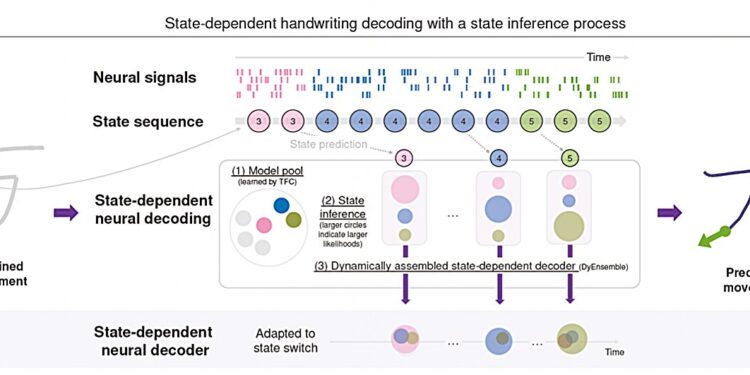The neuronal decoder dependent on the state. Credit: Qi et al.
Compared to other animal species, humans can plan and perform very sophisticated motor tasks, including the ability to write complex characters using their hands. While many previous studies have tried to better understand the neuronal foundations of handwriting and other complex human motor capacities, these have not yet been entirely elucidated.
Previous studies have shown that the engine cortex plays a crucial role in human capacity to translate the intentions into actions. However, the processes via which it allows the execution of precise and sequential movements, such as those associated with handwriting, are misunderstood.
Researchers from the University of Zhejiang in China recently carried out a study aimed at exploring the role of the human engine cortex more in the coding of complex writing, such as Chinese characters. Their results, published in Nature Human behaviorSuggest that this coding takes place via a sequence of stable neural states.
“When we started this project in 2022, we initially aimed to build a Chinese-computer interface system (BCI),” told Medical Xpress Yu Qi, first author of the newspaper. “Although our BCI system can decode the speed of movement for control of the cursor, the reconstruction of Chinese writing was far from satisfactory.
“We were frustrated at the time, because we realized that handwriting is a qualified and sophisticated movement, in particular for Chinese characters (> 3,500 frequent characters composed by 32 types of cerebral accidents), so this could be more difficult compared to control of the cursor.”
Despite their initially disappointing results, IQ and his colleagues continued to work on their BCI writing, by exploring processes via the brain, in particular the Code Code for complex handwriting. In the end, their efforts gave new interesting information that enabled them to improve their human human-machine interface.
As part of their recent study, they carried out a series of experiences in which a human participant was invited to write 306 distinct Chinese characters. While the participant finished the task, the researchers recorded an activity in his engine cortex, to understand the processes involved in the coding of the characters and the execution of the handwriting task.
“The task of experience was simple,” said Qi. “We asked our participant to write Chinese characters one by one, with the advice of a video, just like a game of karaoke for writing. We have recorded a MC neural activity with unique unit of its engine cortex (MC) with two microelectrodes networks while he was doing the handwriting task.”
The brain activity records collected by the researchers have provided new interesting information on the foundations of handwriting, suggesting that the motor cortex codes for complex writing by dividing it into a series of small movement segments or states. In their article, IQ and his colleagues have hypothesized that these states are the primitive units of encoding movement.
“The coding of the movement in MC has shown a property dependent on the State that the coding function remains stable in each state while varying largely between states,” said Qi. “Traditional neural decoders have not taken into account this neuronal property dependent on the state in such a way of decoding the trajectories of writing.
“These results then inspired us to offer the coding and decoding model depending on the state, as well as the development of calculation tools such as TFC and the decoder dependent on the State, which allowed the decoding of Chinese online writing.”
This recent IQ work and his colleagues enrich the current understanding of how the human brain performs more advanced motor tasks that require high levels of precision. In the future, their results could shed light on the development of new BCIs that allow users to write on a computer via their brain signals.
“We are now focusing on the more sophisticated coding and decoding model, and our next objective is to build BCIs capable of controlling various sophisticated fine movements,” added Qi.
More information:
Yu qi et al, the human engine cortex code for complex writing through a sequence of stable neural states, Nature Human behavior (2025). DOI: 10.1038 / S41562-025-02157-X
© 2025 Science X Network
Quote: New overview of how the human engine cortex code for complex writing (2025, April 18) recovered on April 19, 2025
This document is subject to copyright. In addition to any fair program for private or research purposes, no part can be reproduced without written authorization. The content is provided only for information purposes.



